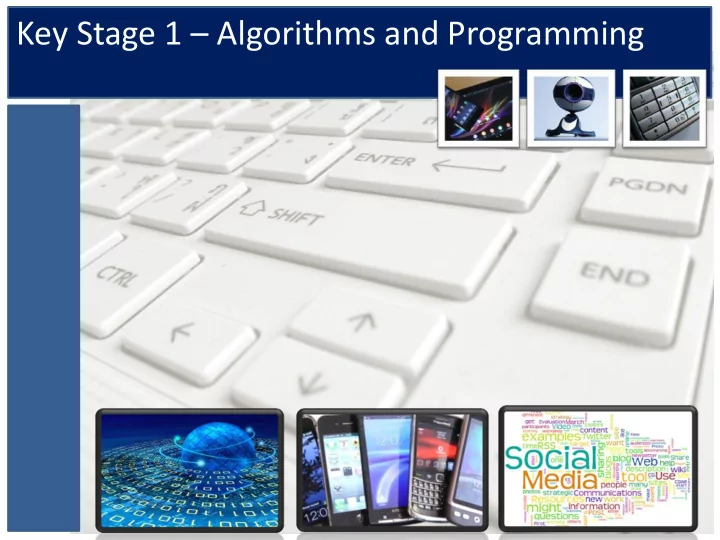

Key Stage 1 – Algorithms and Programming
The Aims By the end of this session, you will: • Explore some activities to teach Algorithms • Look at how to use Programmable Toys • Know what Apps could support KS1 • Become familiar with Scratch • Know about other programs which could help support the Computing Curriculum at KS1
What do we need? We need children to become digitally literate , to develop the knowledge, skills and understanding necessary to participate in todays modern society. This means we need to: • have access to a range of digital technologies • experience using devices in a variety of contexts • embed Information Technology into other subjects • give children access to a range of software, technologies and online tools
Aims of Computing The National Curriculum for Computing aims to ensure that all pupils: • can understand and apply the fundamental principles and concepts of computer science, including abstraction, logic, algorithms and data representation • can analyse problems in computational terms, and have repeated practical experience of writing computer programs in order to solve such problems • can evaluate and apply information technology, including new or unfamiliar technologies, analytically to solve problems • are responsible, competent, confident and creative users of information and communication technology.
Programmes of Study Information Technology Key Stage 1 Computer Science Use technology purposefully to create, organise, store, manipulate and retrieve Key Stage 1 digital content Understand what algorithms are; how they are implemented Digital Literacy – E-Safety as programs on digital devices; Key Stage 1 and that programs execute by following precise and Recognise common uses of information unambiguous instructions technology beyond school Create and debug simple Use technology safely and respectfully, programs keeping personal information private; identify where to go for help and Use logical reasoning to predict support when they have concerns about the behaviour of simple content or contact on the internet or programs other online technologies
3 Areas of Computing Computer Science Over half of the curriculum now focuses on computer science: • Computational Thinking - Algorithms • Programming and Controlling • Networks, The Internet Information Technology • Modelling, Creating & Designing • Photographs, Art, Animations • Data Handling Digital Literacy – E-Safety
KS1 Computer Science Computational Thinking Building, Testing, Predicting Algorithms Programming Bee-Bots, Pro-Bots, Big Track, Light Bot, Robots Programming and Controlling Controlling Devices, Controlling Images on Internet Controlling Characters / Robots
Computational Thinking Algorithms An algorithm is the step by step instructions needed to achieve a specific outcome. It is a sequence of commands Everyday we use algorithms to complete tasks. Getting Dressed Algorithm Brushing Teeth Algorithm Making Tea Algorithm Making a jam sandwich Algorithm
Algorithms - Reception • Display around the room pictures of everyday algorithms alongside the word 'Algorithm‘ to sequence. • Use a kitchen role play area to make cups of tea, sandwiches for a teddy picnic (talk through separate steps) • Blindfold a child robot for others to give instructions to walk through a maze • Use Bee Bots and Mats • Computer Programs - Children to explain 'what happens when' so they understand that the computer is following their instructions.
Algorithms
Algorithms Activity How would you draw the algorithm for your partner to do the Hockey Cokey dance?
Algorithms Activities The Human Crane - Phil Bagge http://www.code-it.co.uk/ks1/crane/humancrane.html Stacking Cups – Thinkersmith http://csedweek.org/unplugged/thinkersmith
Algorithms - Building X
Algorithms – Predicting and Testing X
Algorithms – Predicting and Testing X
Stacking Cups Activity
Stacking Cups Activity
Programming Toys Build, Test and Debug their own algorithms to solve problems Predict outcomes of algorithms given to them
The Bee Bot
Key Words Plan and test algorithms to program a Bee-Bot Algorithm Sequence Forwards Backwards Right Turn Left Turn Commands Debugging
The Probot
Activities Programming the Bee Bot and Probot
Using APP programs Kodable Daisy and Dinosaur Move the Turtle A.L.E.X Cargo-Bot Free 6-8 Free 4+ £1.99 4+ Free 4+ Free 4+ Scratch Junior Scratch Beebot Cato’s Hike Blue Bot Free KS1 £0.69 4+ Free 4+ £2.99 4+
Scratch Junior and Scratch Symbol Sequence Activities Repetition Controlling Characters http://www.scratchjr.org/teach.html Music Machine Racing Car http://www.code-it.co.uk/csplanning.html
Sequence What shape have I programmed with my sequence of instructions? What will happen to my character in this sequence?
Repeat Loops (Repetition) By Phil Bagge
Scratch Junior – ipads only
Solve It! Next, create a sequence for a character and put it into full screen mode. Play the sequence Circle the commands needed for that algorithm
Solve It!
Scratch Programming http://studio.code.org/ A visual programming language that allows children to build computer programs by snapping statements together like Lego blocks using drag and drop Activity Frozen Angry Birds Beginner Courses
Create a Music Machine 2. Import a sound 3. Write the algorithm 1. Draw Button 1 Button 1 Button 2 Button 3
Create an etch a sketch game
Lightbot – Hour of Code http://code.org/learn
2Code, 2Go, 2LOGO
Vocabulary Sequence Repetition All of the ‘ steps ’ that are Statements that perform a repeat followed in order (or loops) Forever , Repeat Debugging Selection Find and fix mistakes in a program Allows the program to make choices according to a condition: Variables if … then…..else Something your program might need that changes s core … speed ……time
Programming in Pairs “… a software development technique in which two programmers work together at one workstation. One, the driver, types in code while the other, the navigator, reviews each line of code as it is typed in. The two programmers switch roles frequently. The Navigator The Driver Thinks direction of outcomes Types the code Suggests improvements Thinks completing task Looks for problems in the code using observer as a guide
Example Overview
Website Support Code It Learn Code http://studio.code.org/ http://code-it.co.uk/csplanning.html Scratch Junior Computer at Schools http://www.scratchjr.org/ http://www.computingatschool.org.uk
Support Website www.pluscomputing.wordpress.com
Recommend
More recommend